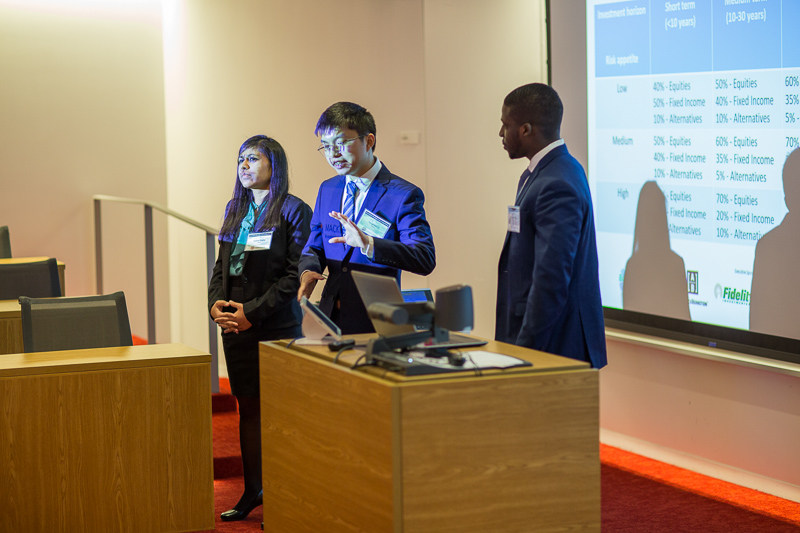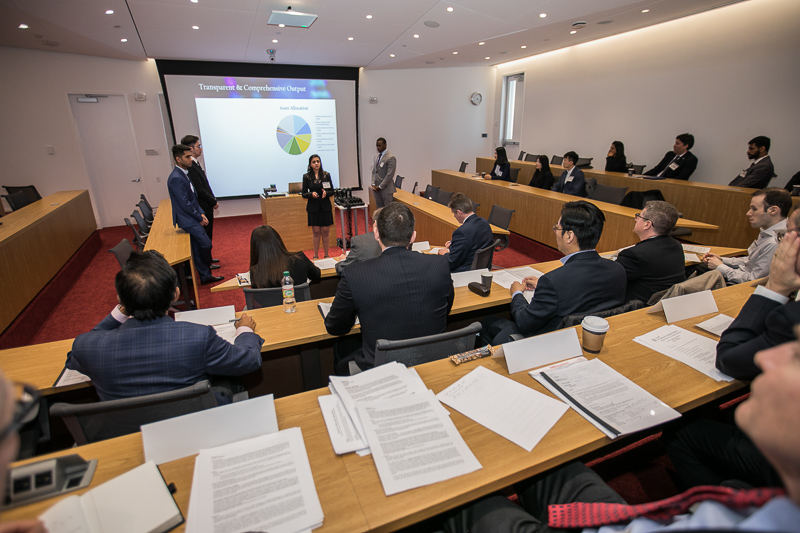2019 Investment Portfolio Case Competition recap: Cross-disciplinary and professionally valuable

By Sakshi Gupta, CFEM ’19
Glancing through the Manhattan skyline from our room at the Warwick Hotel in the wee hours of Friday, February 1, my team and I were geared up to set foot on Roosevelt Island to participate in the third annual Cornell Investment Portfolio Case Competition (IPCC) 2019 organized by Johnson’s Parker Center for Investment Research and Financial Engineering Manhattan. This year, we were to compete with 15 other teams from schools across the country. I had the privilege of representing Cornell in the competition, and my team composed of two first-year MBA students, Chris Barker, MBA ’20, and Prescott Owusu, MBA ’20, and a fellow first-year MFE student, Tengxiao Li. The case presentations were to be judged by panelists from firms including Alliance Bernstein, Mackenzie Investments, and Fidelity Investments.
Putting the act together for our case presentation
Rewind to 10 days ago when the case on robo-advisors was released, our team huddled in Sage Hall discussing in excruciating detail how to approach the solution in order to provide investment recommendations that cover entire customer portfolios.
As the final day approached, my team worked together after classes to brainstorm about the different sections of the case. We had split the sections, taking advantage of individual expertise; Prescott was in-charge of product offerings and investment objectives, while Chris would look into business issues. Tengxiao and I had decided that we would build a prototype asset allocation system for the robo-advisor so as to test our recommended portfolio solution on historical data. Using Excel to historically back-test data from Bloomberg, we then applied the Black-Litterman model to provide a quarterly rebalancing feature to our investment strategy.
On the Thursday before the final presentation, we were informed that Chris, unfortunately, would not be able to join us in New York, as he was unwell. On the team’s arrival at the hotel in New York, we continued rehearsing our presentation to fill in for Chris and fit it into the desired 10-minute PowerPoint deck.
Our final case presentation

All teams, including those from MIT and the University of Rochester, were welcomed by Scott Stewart, faculty co-director of the Parker Center for Investment Research.
We were fourth in sequence to present in our sub-group and ran some last-minute rehearsals to streamline our presentation. Finally, it was our turn to present and we managed to put up a good show. The presentation was followed by a 10-minute Q&A round by the judges. We believed our thorough understanding of the problem statement enabled us to provide suitable answers to the judges’ scrutinizing questions.
After a round of grueling presentations and Q&A, the panel of judges were ready with their verdict, and the four stand-out teams were announced. They would be standing against one another to clinch the title of winner in the 2019 Investment Portfolio Case Competition.
While the finalist teams (unfortunately, ours was not one of them) fine-tuned their presentations, incorporating valuable feedback from their respective first-round judges, we had the opportunity to attend a guest lecture by the keynote speaker Mario Carias, managing director of the CFA Society of New York. In his address, he emphasized the importance of the CFA certification program for those with careers in asset and wealth management. Distinguished members of the judges’ panel were present for the speech and shared their insights on how the charter had strengthened their standing in the financial industry in addition to helping them scale heights in their respective organizations.

Then came the much-awaited final presentations as the two teams from the University of Rochester were pitted against the teams from MIT and Duke University. After neck-and-neck final presentations, first place was given to one of the University of Rochester teams, and second was given to the MIT team. Along with an award ceremony, the participants heard feedback on the competition and a history of how the event had evolved from previous years.
Meeting with finance professionals and fellow participants

The networking reception came soon after the afternoon’s presentations. Participants got an opportunity to interact one-on-one with established finance professionals from Alliance Bernstein, Mackenzie Investments, and Fidelity Investments. I personally got a chance to meet a few Cornell alumni among the judges and receive advice on our investment approach. Participants also interacted with professionals through coffee chats scheduled throughout the day at the venue. Further, it was interesting to understand what went behind the case recommendations of other teams as we shared findings and takeaways with fellow participants.
The case challenge in and of itself was an immense learning experience for me, beginning with strategizing about the investment approach to finally presenting it and receiving feedback from experienced practitioners. The competition not only was a platform to learn about portfolio optimization and to collaborate with MBA counterparts to develop a well-drafted solution to the case but also one to build connections with students from other graduate schools and learn their varied perspectives on the problem statement. I would recommend CFEM and MBA students alike to participate and immerse themselves fully in the competition in the future.

About Sakshi Gupta, CFEM ’19

Sakshi Gupta, is a first-year student in the College of Engineering’s Financial Engineering concentration and Cornell Financial Engineering Manhattan (CFEM) program. Prior to graduate school, she worked as an equity derivatives structuring analyst at JPMorgan as a member of its Global Markets team based in Mumbai, India. In her role as an analyst, she developed Python-based algorithms for structuring of equity derivative indices. Sakshi holds a dual degree in economics and electronics engineering from Birla Institute of Technology and Science. She is a recipient of the Krishnamohan Chaganti MEng Fellowship for spring 2019, and next Summer, Sakshi will be pursuing an internship at American Express on the Credit and Fraud Risk team.

1 Comment
Alka Gupta
While peruseing MFE Course at Cornell University one gets chance to develop business relationships and build sound networking by participating in such competitions. I am happy to see your blog and sure that by sharing your experiences you will definitely help students in their learning curve. Congratulations!!
Comments are closed.